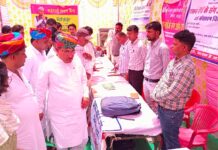
India, the 7th largest country and the second most populous country in the world is looking forward to become the youngest country in the world by 2020. It seems like t is rapidly moving towards the goal as a couple of states contribute including the largest state of the country Rajasthan. Based on the 2011 population data, the 2014 supplementary Census report that has been released last week suggests that every third person in Rajasthan is a minor in the age group of 0-14 years. With this, the state ranks in the top 5 states in the country with the youngest population. Rajasthan ranks below Bihar, Madhya Pradesh and Uttar Pradesh.
According to the report, Rajasthan has a total of 30.5% in the 0-14 years age group of the 6.85 crore population in the state. Bihar leads the country, with a total of 35% of its population in the same age group.
“The state stood fourth youngest in the 0-4 age group in the country in 2014,” says the report.
The previous population data and Census report of 2011 shows that Rajasthan only had 73 lakh people in the 0-4 age group and 80 lakh and 83 lakh people in the 5-9 age group and 10-14 age category respectively. Then, the total population of the state was calculated to be around 6.85 crore. It is only a matter of time where the country has witnessed Rajasthan’s population to jump high in the 0-14 age group and become the third youngest in the country.
“Institutionalized deliveries are fast increasing in the state, leading to a decline in the infant mortality rate (IMR). The IMR, which was 47 for 1,000 births in 2013, fell to 46 in 2014. The unofficial data says that this has fallen further, making the desert state younger by a few more percentage points,” said Nisar Ahmed, a member of an advocacy group. Also, Sanjay Sharma, economist and principal of a private school in Ajmer, says, “This composition would add aggressively to the GDP of the state.”
K B Kothari, former senior advisor, policy and planning at UN in New York, has said, “As Rajasthan stands poised to become younger, the social and spatial inequalities need to be removed quickly.”
“No doubt, the data has thrown up a major surprise. The state has to now come forward to reap the rich dividend of this favorable demographic change. It needs to provide more schools and healthcare facilities for the youth,” Kothari said.








